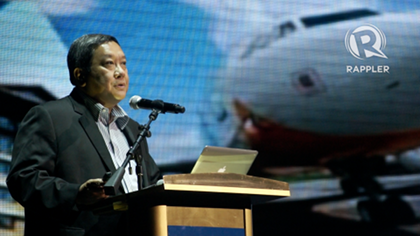SUMMARY
This is AI generated summarization, which may have errors. For context, always refer to the full article.

MANILA, Philippines – With local airlines facing tough times amid high world oil prices and fierce competition, an official of the Philippines’ biggest low-cost carrier shared survival strategies.
Gokongwei-led Cebu Pacific Air has a 3-pronged approach to move ahead in the tough business climate, shared Bach Johann Sebastian, Chief Strategy Officer at the airlines’ parent firm, JG Summit Holdings.
At the COL Financial Group Inc. special customer briefing on October 22, Sebastian enumerated the 3:
- stockpile fuel
- offer cheap, no-frill fares
- look for other airlines to absorb
Jet fuel
Fuel is the single biggest operating cost of an airline, accounting for 40% to 50% of total. Global price fluctuations hurt the bottomline the most.
Cebu pointed to high jet fuel prices when it reported overall 28.9% profit dip in the first 6 months of 2012, even while it’s revenues grew 17.9%.
The airline already bought up to 1/3 of the fuel it expects it will need for the year, explained Cebu Pacific’s strategy chief.
“That is one thing we can do that the other airlines in the Philippines cannot do because, at present, they are not making profits. They will not have the possibility, the credit profile to be able to qualify as a hedge counterpart,” said Sebastian.
Budget model works
He said Cebu Pacific’s budget airline business model is paying off during these tought times.
By continuing their strategy of “unbundled fares” and cutting out frills, like inflight food service, the low-cost carrier (LCC) is able to offer tickets at a lower price and appeal to the price-sensitive Philippine market.
The airline flew the greatest number of passengers in 2011, but rival-Philippine Airlines (PAL) still made more from airline tickets, largely due to the legacy carrier’s international operations.
The other biggest player in the market is legacy airline PAL but there are numerous other low-cost carriers, including Zest Airways, Southeast Asian Airlines, Airphil Express and Air Asia Philippines.
Given that competition is heating up between low-cost carriers, analysts expect smaller airlines will have to merger with bigger ones to stay in the competition.
Cash and acquisitions
Cebu Pacific has already indicated some preliminary interest in Zest Airways, controlld by the group of Alfredo Yao of the Zest-O drinks fame.
“On the competition side, I think we will really have to consider being a consolidator in the Philippine domestic airline business, and perhaps the ability to do that is there because we have the cash in our balance sheet to be able to do that,” said Sebastian.
He added that the airline unit has significant cash-assets with which to make an acquisition. “Our cash is about 25% to 30% of our revenues, which is among the highest among LCCs (low-cost carriers) in the world,” he said.
About 67% of Cebu Pacific is held by the Gokongwei’s JG Summit Holdings. Sebastian explained that the conglomerate’s strategy at the moment is to have each arm build up a cash reserve that can be feed back to the parent company or in the cases of airlines, be used for expansion.
Sebastian broke down the airline’s competitive strategy in the interview below with COL Financial head of research April Lee-Tan.
Full Transcript:
Lee-Tan: Earlier on, you discussed the causes of Cebu Pacific’s underperformance in terms of… rising oil price (and) intensifying competitions; so what are your plans on how to cope with these challenges?
Sebastian: Well for fuel prices, the strategy, really is to hedge about a third of our fuel requirement through the year. We have the hedges up until the end of 2012. We are now beginning to make some hedges for 2013. We don’t hedge more than a year. And we don’t hedge more than a third of our fuel requirements. That is one thing we can do that the other airlines in the Philippines cannot do because, at present, they are not making profits. They will not have the possibly, the credit profile to be able to qualify as a hedge counterpart. But we have that and we have that ability so we’ll try to do that strategically.
But I think more important than that is the ability for us to grow on auxiliary revenue and to try to not increase fares; but to continue to unbundle fares so that passengers only pay for the services that they really need for a particular flight. And that’s the key. And as we grow on auxiliary revenues, those revenues go straight to the bottom-line and that will continue the profitability.
On the competition side, I think we will really have to consider being a consolidator in the Philippine domestic airline business, and perhaps the ability to do that is there because we have the cash in our balance sheet to be able to do that. We have a very healthy balance sheet right now. Our cash is about 25-30% of our revenues, which is among the highest among LCCs (low-cost carriers) in the world; our unit margins are among the highest globally among LCCs.
So we have a good defense, we know that the environment is very negative for us, but we think we have a good defense because we have low cost and we have a healthy balance sheet. So that is going forward. Cebu Pacific can only perform better. There is a need for the industry in the Philippines to be consolidated and we hope to participate in that very actively over the next few years. – Rappler.com with research from Arianna Zapanta
Add a comment
How does this make you feel?
There are no comments yet. Add your comment to start the conversation.